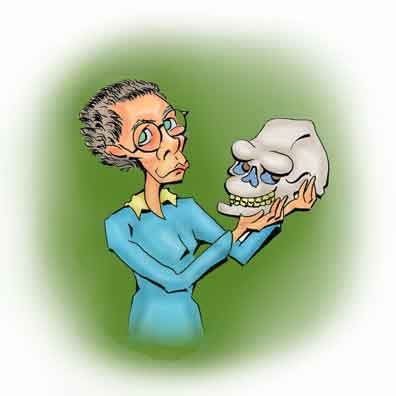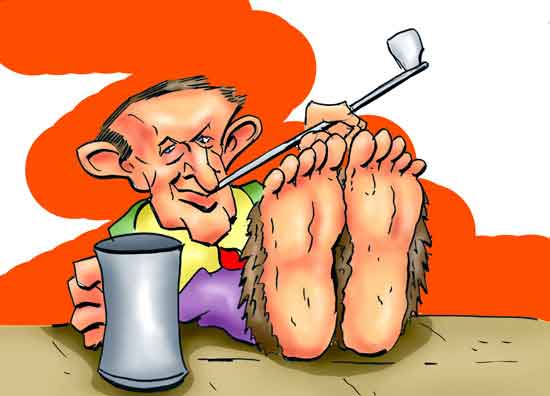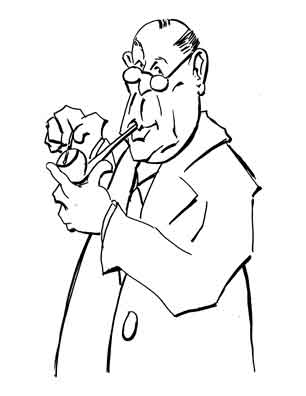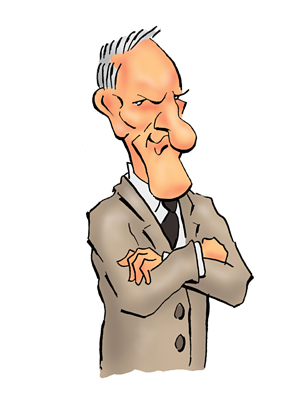
Dorothy Garrod
(and Friend)
Dorothy Garrod
The First
One thing you'll read about Dorothy Garrod is that she was the first woman to be appointed to a professorship at Cambridge University. But although this is true, it was also agin' the rules. Women, it seems, were not allowed to be full members of the University.
But there's one nice thing about the Oxbridge System (or maybe we should say "Cambox"). There was considerable leeway in what the individual faculty could do. For instance Louis Leakey told Jane Goodall she should get a Ph. D. But Jane said she didn't even have an undergraduate degree - she didn't go beyond high school. But that didn't faze Louis. All Jane needed was a faculty member to accept her as a student. And if you got a recommendation from Louis Leakey that was enough. Jane got into the Cambridge graduate school - and her Ph. D.
Dorothy was born in 1892 and came from a cerebral family. Her grandad, Alfred, was knighted and named - get this - Physician Extraordinary by Queen Victoria. Her dad, Archibald, was Regius Professor of Medicine at Oxford and knighted by King George V. Dorothy also had three brothers who also excelled academically.
There's not much known about Dorothy's mother, Laura, and she seems to have been a fairly typical uppercrust Victorian woman. But she must have recognized that her daughter was not going to be contented serving tea and crumpets to the ladies who came calling, and so she supported Dorothy getting a real education. So by the time she was a young woman, Dorothy had the wherewithal to get into Cambridge.
You'll read that Dorothy graduated from Cambridge but strictly speaking this is not correct. But she did attend classes and tutorials and "sat" the examinations (as the British say). But it was against the rules for her - a lady - to get a degree.
Why Cambridge - or it's provincial cousin Oxford - would have colleges for women, let them attend classes and tutorials, take the exams, and yet not permit women to obtain degrees is without doubt one of the most perplexing questions of the sociology of modern English society. But lest Americans get too snooty we should point out that in the same era Harvard and Columbia didn't permit women to enroll although they did have the "sister colleges" of Radcliff and Barnard for women. It wasn't until the 1960's that Radcliff students actually were awarded Harvard degrees. Women were finally admitted to Columbia in 1983.
Dorothy completed her studies at Cambridge one year before World War I broke out. Dorothy's two older brothers were among the nearly one million soldiers killed in battle and the youngest died in the influenza pandemic of 1919. This left Dorothy as the only child.
During the war her dad had served as a physician in Malta, and after the Armistice, Dorothy joined him and her mom on the island. To help cope with the understandable sadness from the loss of her brothers, Dorothy began taking solitary hikes through the countryside. There the Stone Age ruins kindled her interest in archeology, and she enrolled at Oxford in 1919.
Although much has been made of Dorothy's studies with the famous French prehistorian, Henri Breuil, her actual Cambridge advisor - "tutor" in the Oxbridge patois - was Robert Marett. Robert was actually what we would call a cultural anthropologist and was particularly interested in the formation and development of religion in early societies.
But it was Dorothy's time studying in France with Henri that was formative. Henri was a priest but had explored the caves in France and had discovered and copied the paintings left by the early humans. After her brothers' deaths, Dorothy had become a Catholic and so while studying with L'Abbe Henri she could also discuss weighty philosophical matters beyond stones and bones.
Her time with L'Abbe Henri directed Dorothy toward the study of the Paleolithic Era. Sometimes called the Old Stone Age, it is too often called the Era of the Cavemen. Dorothy undertook a massive and comprehensive review of artifacts and skeletal remains that had been found in England. This led to her thesis, The Upper Paleolithic in Britain. It quickly became a classic, and Dorothy got her Bachelors of Science Degree from Oxford in 1924.
Ha? (To quote Shakespeare.) Dorothy wrote a thesis that became a classic of prehistory? And yet she only got a bachelors??!!??

J. R. R. Tolkein
His was honorary.
Yep. You see in the early 20th century a Ph. D. wasn't really that important. It was more like an extra-curriculum activity or "other activities and hobbies" that you put down on your résumé.
Besides, who needed it? At that time the highest earned degree of a lot of college professors was a bachelors. In fact some profs literally looked down their noses at the (ptui) specialization and (double ptui) narrowness of doctoral studies.
On the other hand, if you made major contributions to scholarship there were "research" degrees bestowed by some schools. These degrees were nice because 1) you didn't have to take any more classes, 2) "sit" any more examinations, or 3) write any more theses. You just had to publish your research in a way that impressed the other faculty members.

Jack Lewis
So was his.
For instance, Oxford would sometimes bestow a master's degree - although it was honorary - to graduates who had been at the school for a total of five years. John Ronald Reuel Tolkein earned a BA from Oxford but later worked on the Oxford English Dictionary. This extra work gave him the MA (hon). The MA - again honorary - was also granted for esteemed faculty members - Ronald's friend and fellow faculty member, Clive Staples "Jack" Lewis was awarded an MA. Honorary degrees also went to individuals the school wanted to honor, such as the writer Charles Williams. Charles was a friend of Jack's and a principal editor at Oxford University Press. But Charles, although he had attended college, had never completed his undergraduate degree.

Robert
His degree - like Dorothy's - was earned.
Other bestowed degrees, though, are considered earned degrees. Although increasingly rare there are some schools that offer a Doctor of Science (D. Sc.) which today usually has similar requirements to a Ph. D. But in earlier days the D. Sc. was typically a pure research degree. Sir Robert Robinson, winner of the 1947 Nobel Prize in Chemistry in 1947, never bothered with a Ph. D., but in 1919 was granted a D. Sc. for his work with William Henry Perkin, Jr., at what is now Manchester University. Dorothy was also granted a D. Sc. by Oxford.
Professionally Dorothy specialized in Paleolithic archeology and early hominids. Probably her most significant finds were from the Mount Carmel Caves in Israel. She found skeletons of early humans that had to be classified as Homo sapiens because they had a chin - no other hominid does - but they also had strong brow ridges similar to those of the Neanderthals (Homo neanderthalensis).
Some people say these skulls, somewhat redundantly called the Skūl skulls, were an intermediary link between Neanderthals and modern humans. That the individuals were evidence of Paleolithic hanky-panky has also been posited.
However, there is no reason you have to go from a Neanderthal to a modern man. Both could be examples of divergence from the widespread common ancestor, Homo erectus. The conclusion that the current country of Israel (ergo the former region of Palestine) has been a route from Africa to the rest of the world for multiple millennia is pretty much inescapable. So the people that Dorothy found could very well have been the first modern humans winding their way out of Africa.
During the Second War to (Not) End All Wars, Dorothy joined the Women's Auxiliary Air Force (WAAF). Naturally her war service took quite a chunk out of her professional activities (England was in the war for six years). Fortunately after the war she was able to return to Cambridge and her work.
A somewhat unconventional indication of Dorothy's importance, though, comes not from a list of her academic honors but from a work of fiction. After all, there are few real professors that end up being mentioned in one of the best selling novels of the twentieth century.
In 1965, James Michener published The Source. This was a story of a fictional archaeological dig in Israel. At one point the novel's protagonist, archeologist John Cullinane, is explaining his digging strategy to his staff. He mentions that their site - Tell Makor - is small, but that should not be of concern. As John said:
You'll notice that one of the greatest [archeological excavations] was very small in size, but the results Dorothy Garrod achieved in the Carmel caves were incomparable. She seemed to be digging through deposits of pure gold.
That said, the actions - and attitudes - of some of the male characters in The Source are quite objectionable. Indeed, on a modern dig it could have caused - to quote the Sheriff of Boone County - a heap of trouble. To date, though, no reviewers of the book seem to have commented on the matter, but we suspect that Dorothy would certainly have squelched any such behavior on her digs.
In 1952, Dorothy retired from her professorship but not from archeology. She kept directing excavations but like all of us she eventually had to slow down. Still, in 1965 she was made a Commander of the British Empire (CBE), although certainly she merited a DBE, the ladies' equivalent of a knighthood. Three years later Dorothy died at age 76.
References
Dorothy Garrod and the Progress of the Paleolithic, William Davies and Ruth Charles, Oxbow Books, 2017.
Ladies of the Field: Early Women Archaeologists and Their Search for Adventure, Amanda Adams, Greystone Books, 2010.
"The History of Women at Oxford", Oxford People, Oxford University.
"Prof. Dorothy Garrod", British Museum.
"Who was Dorothy Garrod?", Pamela Smith, Department of Archeology, University of Cambridge.
"Dorothy Annie Elizabeth Garrod ", J. d'A. Waechter, Proceedings of the Royal Anthropological Institute of Great Britain and Ireland, No. 1968, pp. 67-28, 1968. (Reprinted on the Royal Anthropological Institute Website).
"What Does It Mean To Be Human: Skhūl V", Smithsonian Institution, March 29, 2016.
The Source, James Michener, Random House, 1965.